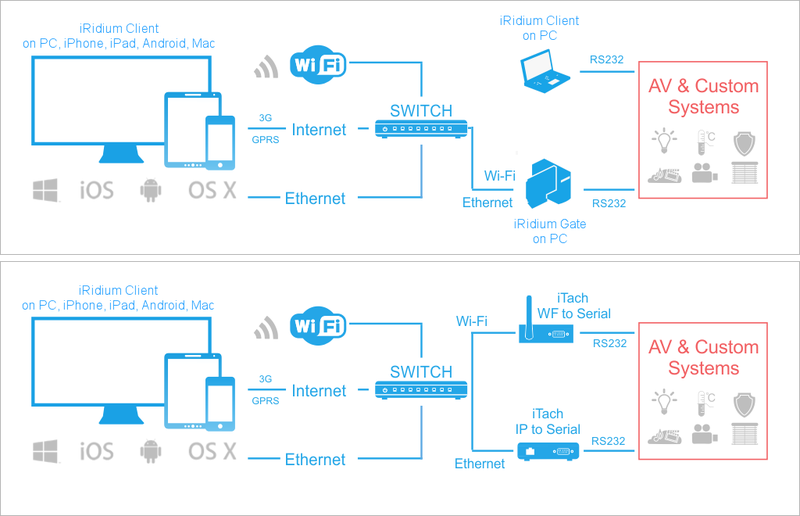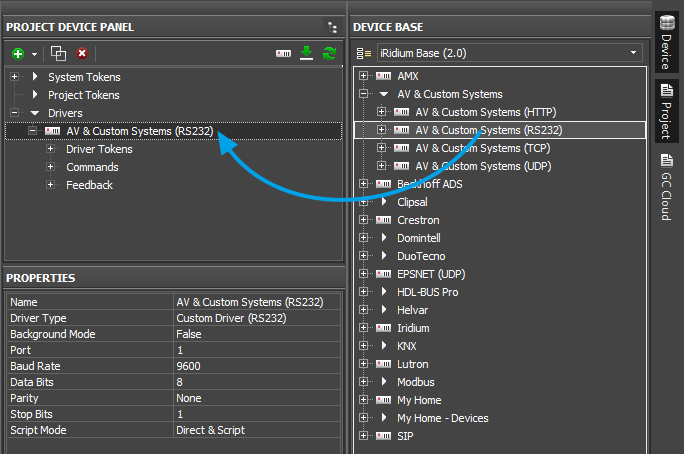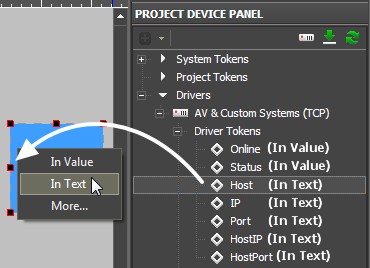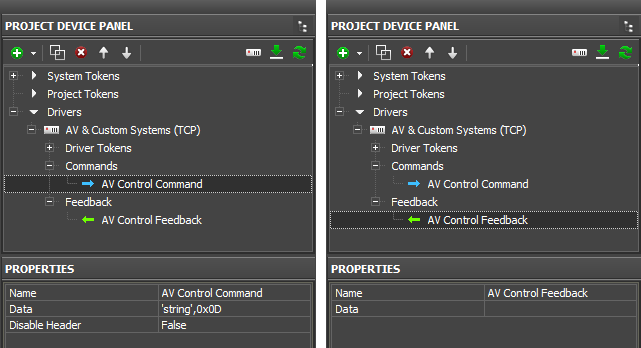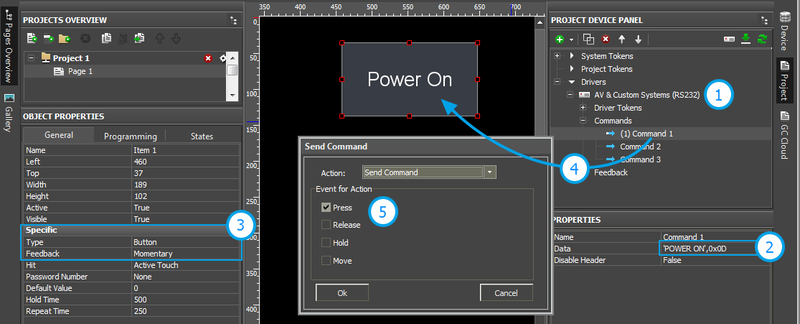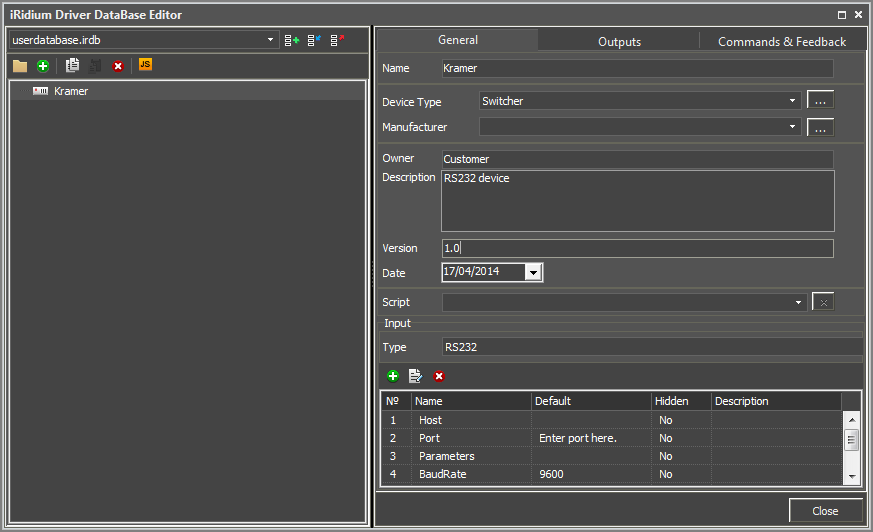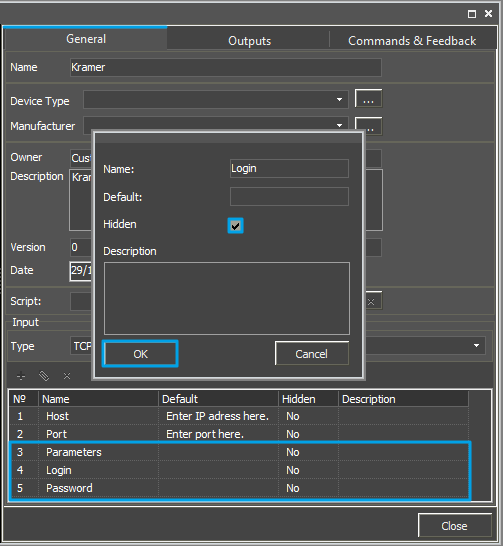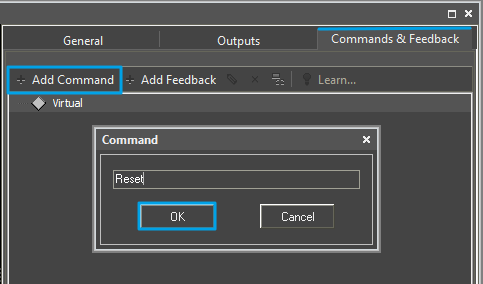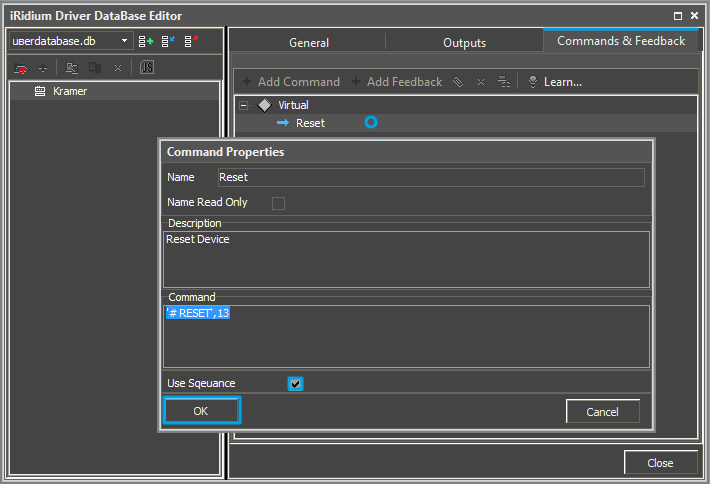AV & Custom Systems (RS232)
Contents
- 1 Work Principles of AV & Custom Systems (RS232)
- 2 Creation and Setting up of the AV & Custom Systems (RS232) Driver
- 3 Structure of the AV & Custom Systems Driver
- 4 Sending Commands to AV Equipment
- 5 Working with AV & Custom Systems (RS232) Commands
- 6 Creation of Your Own Base of AV & Custom Systems (RS232) Commands
iRidium for AV & Custom Systems (RS232) allows you to:
- control any equipment connected to your PC through the COM-port
- send RS232 commands via TCP/IP with the help of "Gate TCP to UDP" and the iRidium Gate application
Conditions for working with the driver:
- possibility to control the selected equipment via RS232 (control interface)
- commands for controlling equipment via RS232 and the protocol
- possibility to create scripts if the protocol suggests authorization and requires data exchange with control panels
Description of driver work:
The "AV & Custom Systems (RS232)" driver connects to the selected COM-port of PC . When the connection is established, you can send commands to the connected equipment – the list of commands is formed by the user in the process of creating a project. Feedback from the equipment is received by processing data by the script crated in the iRidium project iRidium (see iRidium DDK and iRidium Script API).
![]() These instructions describe creation of scripts for processing data received from equipment. Receipt of feedback from equipment is described in the iRidium DDK section.
These instructions describe creation of scripts for processing data received from equipment. Receipt of feedback from equipment is described in the iRidium DDK section.
Work Principles of AV & Custom Systems (RS232)
In iRidium you can use the universal "AV & Custom Systems" (RS232) driver to connect to your Audio-Video and other equipment. The scheme of communication between iRidium and controlled equipment:
![]() This section describes the standard way of using the driver: launch of iRidium on the PC connected to equipment through the COM-port.
This section describes the standard way of using the driver: launch of iRidium on the PC connected to equipment through the COM-port.
![]() For working with equipment via RS232 though Global Cache (iTach) converters, see Global Cache: control via RS232.
For working with equipment via RS232 though Global Cache (iTach) converters, see Global Cache: control via RS232.
Protocol for data sending: RS232.
Supported formats of data exchange: ASCII, HEX, DEC.
Use iRidium syntax for writing commands in different formats.
Feedback from equipment: there is none in the standard variant. It is implemented with the help of iRidium Script, see iRidium DDK.
Required licenses: Device License Pro for AV & Custom Systems (see. Licensing). It works with any equipment controlled with the help of "AV & Custom Systems". It enables use of any scripts in your projects.
Дополнительная информация:
Instructions: iRidium Gate for AV Equipment (RS232 via TCP/IP)
Instructions: Global Cache: control via RS232 (RS232 via TCP/IP)
Creation and Setting up of the AV & Custom Systems (RS232) Driver
Select the AV & Custom Systems tab in the DEVICE BASE window of iRidium GUI Editor. Open it and find "AV & Custom Systems (RS232)". Drag the driver into the PROJECT DEVICE PANEL window:
Properties of connection to equipment using AV & Custom Systems (RS232):
- Background Mode – to work in the background mode (for connection to iOS through iRidium Gate)
- Port – the number of the СОМ-port to which the controller is connected
- Baud Rate – the speed of data exchange
- Data Bits – the number of information bits in a frame
- Parity – control of parity
- Stop Bits – the stop bit in a frame
- Script Mode – the mode of command sending and communication with scripts in iRidium projects
- Direct & Script – data from the command will be sent directly to the equipment and processes by the script system
- Script Only – commands created inside the driver are not sent directly to the equipment but are processed by the script system first.
To connect to equipment from remote devices and via the Internet:
It is required to have a hardware or software converter from TCP/IP to RS232:
- hardware converters Global Cache (GC-100, iTach), see Global Cache: control via RS232.
- software converter iRidium Gate for PC, see iRidium Gate for AV Equipment (RS232 via TCP/IP)
Setting up of the router for working via the Internet:
- 1. Indicate the public address of your Internet router in the Host field
- 3. Set up Port Forwarding on your router to enable remote control of your equipment .
- You can learn the public IP-address of your router with the help of external resources, for example [1]
To switch between local and Internet connection:
Use the example presented below.
Structure of the AV & Custom Systems Driver
The AV & Custom Systems in iRidium projects consists of 3 parts:
- Driver Tokens – the list of variables which store information about connection to equipment
- Commands – the list of commands which can be sent to equipment (or script) by pressing interface buttons
- Feedbacks – the list of feedback channels where data from the controlled equipment (processed by the iRidium script system) can be written.
Properties and applications of the driver parts:
Driver Tokens
Driver Tokens - variables storing the status of connection to the controlled equipment. These properties can be read only.
To use a token, drag it on the graphic item (the token value can be output in the item text field or it can be used to change the item state).
- Online - a state of connection to the controlled system (Online/Offline = 1/0)
*Status - the status of connection to the system (Offline/Connecting/Online/Waiting = 0...3) *Port - the PC COM-port through which the connection to the remote device is established
Commands and Feedbacks
Commands – the list of commands which can be sent to the equipment (or scripts) by pressing interface buttons. It is filled at random. The number of commands is not limited.
Feedbacks – the list of feedback channels where data from the controlled equipment (processed by the iRidium script system) can be written. The data written in the Data filed of the Feedback channel can be read using the script.
Commands
- Name - the command name, at random
- Data - the data the command has to send at the activation. They can be written in HEX, DEC, ASCII
- Desable Header – it is used only for Global Cache modules and ready script drivers. Leave “False” by default.
Feedback
- Name – the feedback channel name. You can refer to the channel from scripts for writing data.
- Data – the data which the feedback channel stores at the project launch. They can be rewritten with the help of graphic item commands or scripts.
To assign a command to a graphic item:
drag it on the graphic item and select the event on which it should be sent:
- Press – pressing on the item
- Release – releasing the item
- Hold – holding the item
- Move – moving on the item (it is mostly used for Level)
To assign a feedback channel to a graphic item:
drag it on the graphic item and select what it should affect:
- In Value – when receiving any non-zero value the item will change its state (State 1/State 2). It is used for visualizing changes by changing the item appearance.
- In Text – when receiving any data they will be written in the item text field
- More... – the received data can affect any other item properties (see the available properties in the dialog window)
Sending Commands to AV Equipment
Select the commands you need to add in the list of the AV & Custom Systems (TCP) driver. They can be stored in one of the following formats:
- ASCII - string
- HEX – hexadecimal
- DEC - decimal
You need to prepare the information which is stored in one of these formats correctly so iRidium could process it and send to the equipment. Use iRidium "syntax" for forming commands of the AV & Custom Systems driver. The syntax is similar for TCP, UDP, RS232.
Commands in the ASCII Format (Strings)
Add a ASCII string in the "Data" window:
- include it in ‘single quotes’.
- if the string is followed by data in a different format, separate them with commas
| Initial command (in documentation): |
PWR01 | VOLUME 50 | AUD 1>3 | 6CH/8CH <CR> <LF> |
| In iRidium (the Data field): |
'PWR01' | 'VOLUME 50' | 'AUD 1>3' | '6CH/8CH',0x0D,0x0A |
The "carriage return" <CR> and "line end" <LF> symbols:
| In documentation: | <CR> | <CR> | <CR> | <LF> | <LF> | <LF> |
| In iRidium (the Data field): | 0x0D | $0D | 13 | 0x0A | $0A | 10 |
You can use any of the 3 variants for indicating the line end.
Commands in the HEX (Hexadecimal) Format
Add HEX data in the "Data" window:
- write $ or 0x before each HEX symbol
- do not use blank spaces, divide HEX symbols with commas
- if there are additional symbols near HEX symbols in your documentation, remove them (FFh > FF)
| Initial command (in documentation): |
01 81 81 81 | 19h EEh A1h C1h | 16 8A FF FF <CR> <LF> |
| In iRidium (the Data field): |
0x01,0x81,0x81,0x81 | 0x19,0xEE,0xA1,0xC1 | 0x16,0x8A,0xFF,0xFF,0x0D,0x0A |
The "carriage return" <CR> and "line end" <LF> symbols:
| In documentation: | <CR> | <CR> | <CR> | <LF> | <LF> | <LF> |
| In iRidium (the Data field): | 0x0D | $0D | 13 | 0x0A | $0A | 10 |
Commands in the DEC (Decimal) Format
Add DEC data in the "Data" window:
- do not use additional symbols
- do not use blank spaces, divide symbols with commas
| Initial command (in documentation): |
01 255 255 05 25 | 20 30 40 50 <CR> <LF> |
| In iRidium (the Data field): |
01,255,255,05,25 | 20,30,40,50,13,10 |
The "carriage return" <CR> and "line end" <LF> symbols:
| In documentation: | <CR> | <CR> | <CR> | <LF> | <LF> | <LF> |
| In iRidium (the Data field): | 0x0D | $0D | 13 | 0x0A | $0A | 10 |
Working with AV & Custom Systems (RS232) Commands
Example of using commands for AV & Custom Systems (RS232):
- 1. Add the AV & Custom Systems (RS232) driver in your iRidium project. Set up properties of connection to the equipment.
- 2. Create a command. Indicate data for sending to equipment in the Data field.
- 3. Set up the button which will be responsible for sending the command.
- Type: Button
- Feedback: Momentary
- 4. Drag the command on the button.
- 5. Select the event the on which the command will be sent:
- Press – pressing on the item
- Release – releasing the item
- Hold – holding the item
- Move – moving on the item (it is mainly used for Level)
![]() You cannot change the command in the Data field when the project is already uploaded on your control panel. It means that if your command, for example, is responsible for setting the volume to 50%, it cannot be assigned to Level for gradual volume regulation. It will work only with Button and set the volume to 50% at each pressing.
You cannot change the command in the Data field when the project is already uploaded on your control panel. It means that if your command, for example, is responsible for setting the volume to 50%, it cannot be assigned to Level for gradual volume regulation. It will work only with Button and set the volume to 50% at each pressing.
![]() To send values (e.g. volume) сfrom Level, you need to from the command with the help of scripts (see iRidium Script API and iRidium DDK), not in the project tree.
To send values (e.g. volume) сfrom Level, you need to from the command with the help of scripts (see iRidium Script API and iRidium DDK), not in the project tree.
Creation of Your Own Base of AV & Custom Systems (RS232) Commands
To use AV & Custom Systems (RS232) in any iRidium project you need to save it in the iRidium data base.
Use DB Editor for adding devices. New devices can be added only to custom data bases as standard data bases cannot be edited.
![]() Creation of data bases is not the only way of transferring commands from one iRidium project to another. If you created a device with commands in your iRidium project, you can import it to another project using File > Import > *.irpz
Creation of data bases is not the only way of transferring commands from one iRidium project to another. If you created a device with commands in your iRidium project, you can import it to another project using File > Import > *.irpz
Creating Data Bases
Use custom data bases for storing your devices. They are created in DB Editor. When creating a data base, indicate its name and directory for saving.
Creating new devices:
The type of the created device - RS232 (RS232 Device) – defines its transport part and characteristics.
Setting up UDP devices
Describe new devices to help with their further identification:
- Device Type – the type of the controlled device (TV, DVD, Blu Ray, ...)
- Manufacturer – the name of the device manufacturer
- Description – description of the device, it can include hyper links
- Date – the date of creating the driver
Properties for connection:
- Port – the number of the СОМ-port to which the controller is connected
- Baud Rate – the speed of data exchange
- Data Bits – the number of information bits in a frame
- Parity – control of parity
- Stop Bits – the stop bit in a frame
Optional properties:
- Parameters – additional properties for connection
- Login
- Password
The optional properties can be hidden: click two times on the property to open the window for settings and select Hidden.
Adding commands in the list of devices
Go to the Commands & Feedback tab and use tools of iRidium GUI Editor:
The command is empty by default. The instruction the command should send is indicated in the Command Properties window. Click two times on the created command to open the Command Properties window.
- Write the instruction for the command in the Command field of the opened window. In our case for the Reset command (device resetting) there is the '# RESET',13 instruction, where# RESET is the instruction content, 13 = <CR> (the command is sent in the ASCII format).
- Mark the Name Read Only field if you do not want to change the command name in the future (it is used when the driver works with scripts which refer to the command identifying it by its name).
- In the Descriptions field indicate the command description.
When all commands are added, you can close the DB Editor window.
